Vibrations, Waves, and Sound
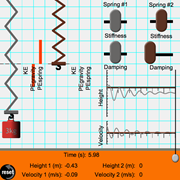 Vibrating Mass on a Spring
Vibrating Mass on a Spring
Pick up a mass and place it on the end of a spring and watch the mass bob up and down. Pull it off the spring and try placing a different mass on the end of the spring. Or use both springs and place different masses on each one of them. Ready to measure? Just click the Start button and the height of the mass, the velocity at which it is moving, and the time will all be measured and plotted on a graph. Values go by too fast? No problem with this Interactive - just drag a slider backwards across the graph and view height, velocity and time values at any point on the graph. As if that were not enough, you can also change the nature of the spring - changing both its stiffness and the amount of damping. This simulation is so realistic it is almost as if you are manipulating the real thing.

Now available with a Concept Checker.
 Pendulum Motion
Pendulum Motion
It's not too difficult to make a pendulum from a string and a mass ... and every Physics student studying vibrational motion should do so. But once you've done the hands on, this simulation would be a great next step. It simulates (among other things) the back-and-forth motion of a pendulum while displaying numerous representations that highlight the concepts associated with force, velocity, and energy. (NOTE: This simulation is identical to the Vertical Circle Simulator found in our
Circular and Satellite Motion section.)

Now available with a Concept Checker.
Thanks to Physics teacher Martin Kirby for contributing this simulation to our Physics Interactives collection.
Find more great Martin Kirby simulations
here.
 Spring Quiz
Spring Quiz
It's the often-dreaded vibrating mass on a vertical spring problem. But this time your results will be different. This Interactive will incrementally step you through the problem with hints and feedback.
Thanks to Physics teacher Martin Kirby for contributing this Interactive to our Physics Interactives collection.
Find more great Martin Kirby simulations
here.
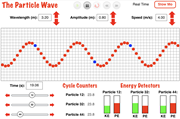 The Particle Wave
The Particle Wave
Get 60 particles together. Connect them by springs. Vibrate the first one back and forth at a regular rate. What do you get? You might be surprised but you're going to have to visit the simulation to find out. The Particle Wave simulation allows you to explore the nature and properties of a wave. Properties such as wavelength, amplitude, and speed can be changes. The effects of the change on the wave pattern and particle motion can be immediately observed.

Now available with a Concept Checker.
 Transverse Sine Wave Maker
Transverse Sine Wave Maker
You could try to rig this contraption up at school but it would probably be a bit difficult. So we did it for you and added some 3D viewing effects to give it more realism. It's a marker attached to a turntable. The marker oscillates back-and-forth one complete cycle as the turntable makes one complete revolution. Underneath the marker is a long spool of butcher paper that moves as the marker oscillates back and forth and leaves a trace on the butcher paper. What are you going to see on the butcher paper? We're not going to tell you that part. You'll have to click the link and see for yourself.
Almost forgot: don't forget to tap down and drag the contraption to view it in 3D. It's quite mesmerizing. You could probably spend the entire class period (English class, that is) playing with it.
Thanks to Physics teacher Martin Kirby for contributing this simulation to our Physics Interactives collection.
Simple Wave Simulator
Whether seen in a science museum or inside a physics classroom, everyone is intrigued by a wave machine. One can watch and observe the periodic motion of a mechanical wave machine in amazement without knowing that 30 minutes just passed by. Prepare yourself because you are about to observe a virtual wave machine ... only now you (not the museum official or your teacher) are in control. You can set it vibrating at any frequency and any amplitude you wish. You can even view it simulating a sound wave. Watch it vibrate in slow motion. Watch it in fast motion. Watch it in real time. And watch the clock because you're going to be so captivated that you might be late for your next class.

Now available with a Concept Checker.
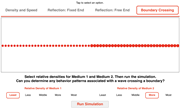 Boundary Behavior of Waves
Boundary Behavior of Waves
When a wave reaches the end of a medium, it doesn't just stop. But what does it do? In this simulation, you are certain to find out. View an incident, reflected, and transmitted pulse and observe how their speed, wavelength, and amplitude is dependent upon the density of the medium. It's like having a wave machine on your screen ... but you can take your time, repeat a trial, and easily investigate the answer to what happens when a wave reaches the emd of a medium.

Now available with a Concept Checker.
Slinky Lab
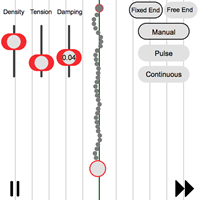
Grab a particle on a string and start wiggling it back and forth. Watch as the disturbance you create travels from particle to particle. Explore the result of wiggling more or less frequently or with a smaller or larger amplitude. Change the amount of damping effects and other variables. You'll have so much fun with Slinky Lab that you might forget that you're learning physics.

Now available with a Concept Checker.
The Physics Classroom thanks their friends at
Nerd Island Studios for contributing this Interactive to the collection.

When two or more waves meet up with each other while moving through the same medium, interference occurs. When you try to observe this phenomenon in real life, the two waves become
lost in one another and it becomes difficult to perceive the principles that underlie the phenomenon. But this simulation comes to the rescue, allowing the learner to step through in slow motion and view the individual waves and the resulting shape of the medium. So drop that Slinky for a moment; you can get back to it later. But for now, take some time to explore the Wave Addition simulation and find out what is happening when you and your friend give each end a shake.
Thanks to Physics teacher Martin Kirby for contributing this simulation to our Physics Interactives collection. You can learn more about the Wave Addition app for iOS devices at
Mr. Kirby's Google Site.

Now available with a Concept Checker.
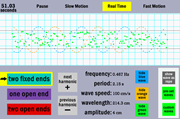 Standing Wave Maker
Standing Wave Maker
If you have ever seen a standing wave demonstration, then you have seen the definition of
groovy (excuse the 80s term). And
groovy is what you will see when you open this simulation. Make standing waves from several pre-set conditions or set the conditions yourself. View two waves traveling in opposite directions and the standing wave pattern that results from their interference. Don't forget to say
Groovy!

Now available with a Concept Checker.
Thanks to our friends at
Nerd Island Studios for contributing a little bit of
groovy to our Physics Interactives collection.
(Need the definition of groovy? Click
here.)
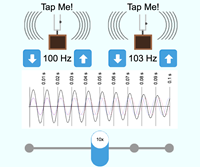 Beat Patterns
Beat Patterns
If you have ever tried to tune an instrument, you likely used the phenomenon of beats. Or if you've observed the orchestra attempting to tune their instruments to one another, you likely observed them utilizing beats. Just exactly what is the concept of beats? And what physics is involved in beats? In this Interactive, you will use two virtual tuning forks to explore the answers to these questions. Give them a tap, set them into vibrations, and observe the result.
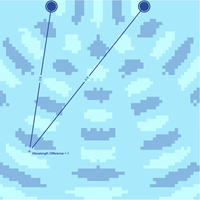 Ripple Tank Simulator
Ripple Tank Simulator
We know. That pesky ripple tank apparatus is a pain to set up. If all you wish to demonstrate is the concept of two-point source interference, here's a painless alternative - the Ripple Tank Simulator. Let the sources begin vibrating and view the pattern. Can you see the nodal and antinodal lines/ Now tap on one of the lines and let the simulator make measurements of the distance to the course and calculate the path difference (difference in the two source-to-point distances). Can you find a pattern?
(From our Light and Color section.)
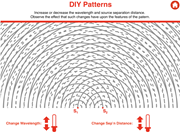 Two Point Source Interference Patterns
Two Point Source Interference Patterns
Grab a ripple tank and disturb the water at a periodic rate in two locations. What do you get? A two-point source interference pattern. Don't have a ripple tank? Then use ours. Explore the patterns that results when waves from two source interfere. Easily change the wavelength or the distance between sources and repeat a trial.

Now available with a Concept Checker.
(From our Light and Color section.)
 Audio Analyzer
Audio Analyzer
Grab your tuning forks and get ready to dig into the Audio Analyzer. This interactive uses any microphone device on your computer, phone, or tablet to capture and display the sound produced, with an estimated pascal pressure and time readout anywhere along the sound wave.
Data Transmission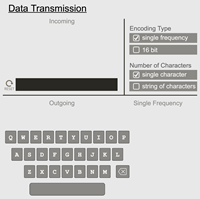
How do devices use waves to transmit and receive information? Use our Data Transmission simulation to experiment with data transmission. Grab two devices, open the simulation on each decice, and start communicating with one another. Shhhh! Transmitting and receiving allowed; talking prohibited.
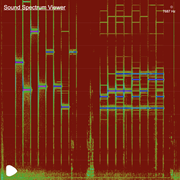 Sound Spectrum Viewer
Sound Spectrum Viewer
The Sound Spectrum Viewer was created to be used as an accompaniment to our Data Transmission Interactive (above). It will capture a sound sound from any source and graphically display the sound's spectrum over the course of time. The tool will display a spectrogram and a Fast Fourier Transform (FFT) of the collected sound.